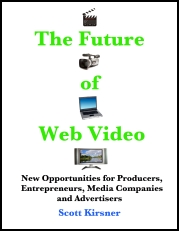Now this catches my attention: a no-nonsense video site that hopes to attract independent producers who can't get distribution otherwise. It's free, and new, and seems to have done many things right. A production's materials are grouped together, each item is nicely displayed. Each video has a URL, and they make it easy to send emails to friends or embed a video into a website or blog (like this). It DOES require a player download (a fairly smooth process, though I understand a bit ungainly for Mac users right now). This embedded version is in Flash (lower resolution than the .wmv files that are distributed via the P2P network).
Here are some interesting items from the FAQ:
How does Dovetail utilize peer-to-peer (P2P) technology?
Dovetail can afford to distribute high-resolution video, including HD quality, because it uses a peer-to-peer technology. This means that when you download a file from Dovetail you are not downloading the file solely from Dovetail servers: you are also downloading pieces of the file from other users, like you. As a user of Dovetail, this also means that you will take part in the network, so that other users will download pieces of content from your computer as well.
Dovetail software is actively utilizing P2P when the content engine is on, and only accesses files associated with the data that you are downloading. Dovetail will not access or upload any other files, or obtain any personal information about you as a result of this activity.
Is it safe to leave the content engine running when I'm done working with the Dovetail Showcase?
Leaving the content engine running (the Dovetail icon in the system tray) is safe and it is important for Dovetail to function properly. You should always leave the Dovetail content engine running, because that is how we download content to your computer. As long as the engine is running, we will be providing you with new high-quality content.
Note: If you have selected content that you want to download using the Dovetail Showcase, you do not have to leave your browser open. Leaving the content engine running will allow downloads to complete.
Why is Dovetail encrypted?
This means better films and shows for you, the viewer. We believe in supporting the rights of content owners. The filmmakers and producers who use our system have the right to trust that their content will be watched under the terms of their agreement and through Dovetail only. If a filmmaker chooses to remove their content, we want to support their choice by removing it. If we didn't encrypt the content, filmmakers would lose their ability to remove content from our system. Because they can remove it and because they trust us, filmmakers are willing to share better films and shows, and that means better content for you, the viewer.

































